Scientific classification
Kingdom:
Phylum:
Arthropoda
Class:
Malacostraca
Order:
Decapoda
Family:
Scyllaridae
Genus:
Scyllarus
Species:
S. Arctus
Binomial name (link Wikipedia)




Lesser Locust Lobster
Petite Cigale de Mer
Kleiner Bärenkrebs
Santiaguiño
Kleine Beerkreeft

Description
Scyllarus arctus is a species of slipper lobster which lives in the Mediterranean Sea and eastern Atlantic Ocean. It is uncommon in British and
Irish waters, but a number of English-language vernacular names have been applied, including small European locust lobster, lesser slipper
lobster and broad lobster.
Scyllarus arctus may reach up to 16 centimetres (6.3 in) long, although sizes of 5–10 cm (2.0–3.9 in) are more typical. It is reddish-brown in
colour, with a dark brown spot in the centre of each abdominal somite, although this is not sharply defined. The pereiopods have a dark blue ring
around each segment. It can be told apart from its close relative Scyllarus pygmaeus, which lives sympatrically with S. arctus, chiefly by its larger
size, but also by other features such as the shape of a tubercle on the last thoracic sternite; this is flattened in S. arctus, but conical in S.
pygmaeus. S. arctus has among the smallest measured genome sizes in the Order Decapoda, at less than a third of that seen in the related
genus Scyllarides.
S. arctus is found throughout the Mediterranean Sea, and in eastern parts of the Atlantic Ocean, from the Azores, Madeira and the Canary
Islands as far north as the English Channel.

Animalia
Scientific classification
Kingdom:
Phylum:
Arthropoda
Class:
Malacostraca
Order:
Decapoda
Family:
Scyllaridae
Genus:
Scyllarides
Species:
S. Latus
Binomial name (link Wikipedia)




Slipper/Rock Lobster
Grande Cigale de Mer
Grosser Bärenkrebs
Langosta Canaria
Grote Beerkreeft
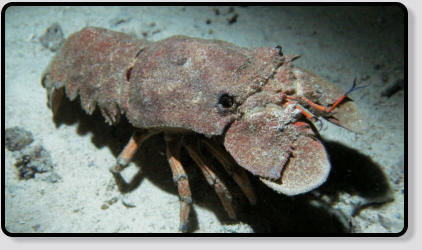
Description
Scyllarides latus, the Mediterranean slipper lobster, is a species of slipper lobster found in the Mediterranean Sea and in the eastern Atlantic
Ocean. It is edible and highly regarded as food, but is now rare over much of its range due to overfishing. Adults may grow to 1 foot (30 cm) long,
are camouflaged, and have no claws. They are nocturnal, emerging from caves and other shelters during the night to feed on molluscs. As well
as being eaten by humans, S. latus is also preyed upon by a variety of bony fish. Its closest relative is S. herklotsii, which occurs off the Atlantic
coast of West Africa; other species of Scyllarides occur in the western Atlantic Ocean and the Indo-Pacific. The larvae and young animals are
largely unknown.
S. latus can grow to a total body length about 45 centimetres (18 in), although rarely more than 30 cm (12 in). This is equivalent to a carapace
length of up to 12 cm (4.7 in). An individual may weigh as much as 1.5 kilograms (3.3 lb). As in all slipper lobsters, the second pair of antennae
are enlarged and flattened into "shovels" or "flippers". Despite the name "lobster", slipper lobsters such as Scyllarides latus have no claws, and
nor do they have the protective spines of spiny lobsters. Instead, the exoskeleton, and particularly the carapace, are thicker than in clawed
lobsters and spiny lobsters, acting as resilient armour. Adults are cryptically coloured, and the carapace is covered in conspicuous, high
tubercles.
Scyllarus latus is found along most of the coast of the Mediterranean Sea (one exception being the northern Adriatic Sea), and in parts of the
eastern Atlantic Ocean from near Lisbon in Portugal south to Senegal, including the islands of Madeira, the Azores, the Selvagens Islands and
the Cape Verde Islands.
Animalia
Scientific classification
Kingdom:
Phylum:
Arthropoda
Class:
Malacostraca
Order:
Decapoda
Family:
Palinuridae
Genus:
Panulirus
Species:
P. Echinatus
Binomial name (link Wikipedia)




Painted Spiny Lobster
Langouste
Languste
Langosta de Antena
Langoest

Description
Panulirus echinatus, the brown spiny lobster, is a species of spiny lobster that lives on rocky reefs in the tropical western Atlantic Ocean and
central Atlantic Islands.
Like other spiny lobsters Panulirus echinatus has no pincer-like chelae on its front walking legs. It differs from related species by having just two
large spines on the antennular plate, just in front of the carapace, and the exopod of the third feeding appendage is reduced and bears no
flagellum. The basic colour is brown with large white rounded spots. The antennules and limbs are brown and have longitudinal white or yellow
markings. The average size varies over different parts of its range, with males growing to a carapace length of about 19 cm (7.5 in) and females
15 cm (6 in). Males are in general more numerous, larger and heavier than females but this may be because of behavioural differences, with
females feeding less during the breeding season.
Panulirus echinatus is found off the coasts of northern Brazil and on the Atlantic Islands of Cape Verde, Saint Helena, Ascension Island, Tristan
da Cunha and the Canary Islands
Animalia


Harry van Goor 2016
source: Wikipedia, the free encyclopedia


Categories: Lobsters
Scientific classification
Kingdom:
Phylum:
Arthropoda
Class:
Malacostraca
Order:
Decapoda
Family:
Enoplometopidae
Genus:
Enoplometopus
Species:
E. Antillensis
Binomial name (link Wikipedia)




Red Reef Lobster
Cigale Canarienne
Roter Riffhummer
Cigala Canaria
Rode Rif Kreeft
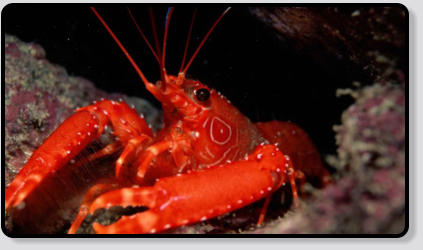
Enoplometopus antillensis (commonly dwarf reef lobster, Atlantic reef lobster or flaming reef lobster) is a species of reef lobster endemic to
warmer parts of the Atlantic Ocean. It is found at depths of 5–201 m (16–659 ft) in rocky and coral reefs, where it hides in small crevices. Dwarf
reef lobsters are prized in the home aquarium hobby for their bright colors and small size
No further information available on Wikipedia.
Description
Animalia

Scientific classification
Kingdom:
Phylum:
Arthropoda
Class:
Malacostraca
Order:
Decapoda
Family:
Galatheidae
Genus:
Galathea
Species:
G. Squamifera
Binomial name (link Wikipedia)




Squat Lobster
Cancer du Printemps
Springkrebs
Langosta Agazapada
Zwarte Galathea
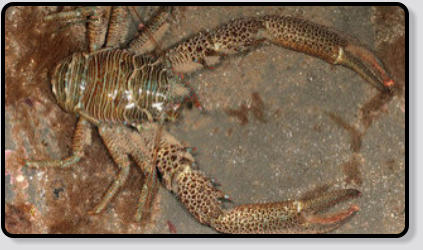
Galathea squamifera, the black squat lobster, or Montagu's plated lobster, is a species of squat lobster that lives in the north-east Atlantic Ocean
and Mediterranean Sea.
Adults are up to 65 millimetres (2.6 in) long, with a carapace 32 mm (1.3 in) long; the body is chestnut brown with a green tinge, and the spines
projecting from the carapace are red at the tips. The rostrum is triangular in shape with four spines on either side. The first pair of pereiopods are
1½ times as long as the body, and have well-developed claws.
G. squamifera is found from Norway to the Azores and in the Mediterranean Sea, and is the most commonly found species of squat lobster on
the shores of Northern Europe. It lives between the low water mark and depths of about 70 metres (230 ft), under stones and in rock fissures.
G. squamifera is chiefly nocturnal, and catches passing prey, such as small fish, with its claws. Species which feed on G. squamifera include the
fishes Scorpaena porcus and Serranus atricauda
Description
Animalia






Scientific classification
Kingdom:
Phylum:
Arthropoda
Class:
Malacostraca
Order:
Decapoda
Family:
Diogenidae
Genus:
Allodardanus
Species:
D. Calidus
Binomial name (link Wikipedia)




Hermit Crab
Bernard L’Hermite
Einsiedlerkrebs
Cangrejo Ermitaño
Heremietkreeft
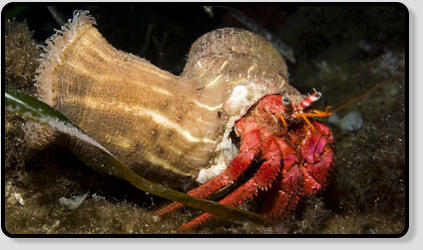
Dardanus calidus is a species of hermit crab from the East Atlantic (Portugal to Senegal) and Mediterranean Sea.
D. calidus can grow to a length of 12 centimetres (4.7 in). It uses large gastropod shells, such as those of Tonna galea and Charonia species,
which it often decorates with one or more sea anemones of the species Calliactis parasitica. The relationship with the anemone is truly symbiotic,
since the anemone gains scraps of food from the hermit crab, while the crab benefits from the anemone's stinging tentacles deterring predators.
Dardanus calidus is a scavenger, feeding on decaying matter from the sea bed.
It has been collected from depths greater than 100 metres (330 ft), but is more typically found in shallower water.
Description
Animalia


Scientific classification
Kingdom:
Phylum:
Arthropoda
Class:
Maxillopoda
Order:
Na.
Family:
Balanidae
Genus:
Balanus
Species:
Balanus Sp.
Binomial name (link Wikipedia)




Keeled Barnacle
Balanus Sp.
Gekielte Seepocke
Balano
Rankpootkreeft / Zeepokke
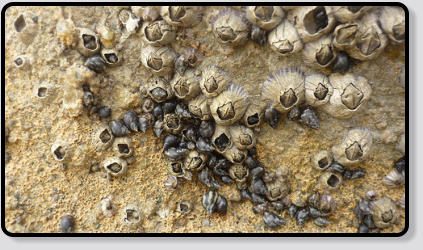
Balanus is a genus of barnacles in the family Balanidae of the subphylum Crustacea.
Fossil shells of Balanus from Pliocene.
This genus is known in the fossil record from the Jurassic to the Quaternary periods (age range: from 189.6 to 0.0 million years ago.). Fossil
shells within this genus have been found all over the world.
The bodies of these organisms are totally enclosed by a stony gray-whitish shell. The size of these shells ranges from 5 millimeters to 10
centimeters. They take the form of a cone consisting of six plates fixed on the rocks. The active animal can only be observed within the water
when the shell opens and the barnacles expose two branched appendages (cirri ) regularly hitting the water to catch food. They mainly feed on
plankton.
Description
Animalia

